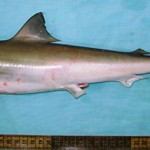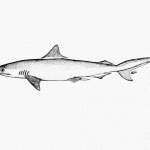Species: Rhizoprionodon oligolinx
English Name: Grey Sharpnose Shark
Chinese Name: 寡线斜锯牙鲨
Family: Carcharhinidae
Description:
The Grey Sharpnose Shark has long labial furrows, short pectoral fins and position of anal fin origin is well in front of second dorsal fin origin. Can grow up to a length of 70cm for male and female. Lives inshore and offshore on continental and insular shelves. Feeds on fishes, cephalopods, and crustaceans. Commercialized for human uses.


Photos used under a Creative Commons license
References:
– Compagno, L.J.V., 1984. FAO Species Catalogue. Vol. 4. Sharks of the world. An annotated and illustrated catalogue of shark species known to date. Part 2 – Carcharhiniformes. FAO Fish. Synop. 125(4/2):251-655. Rome: FAO.

